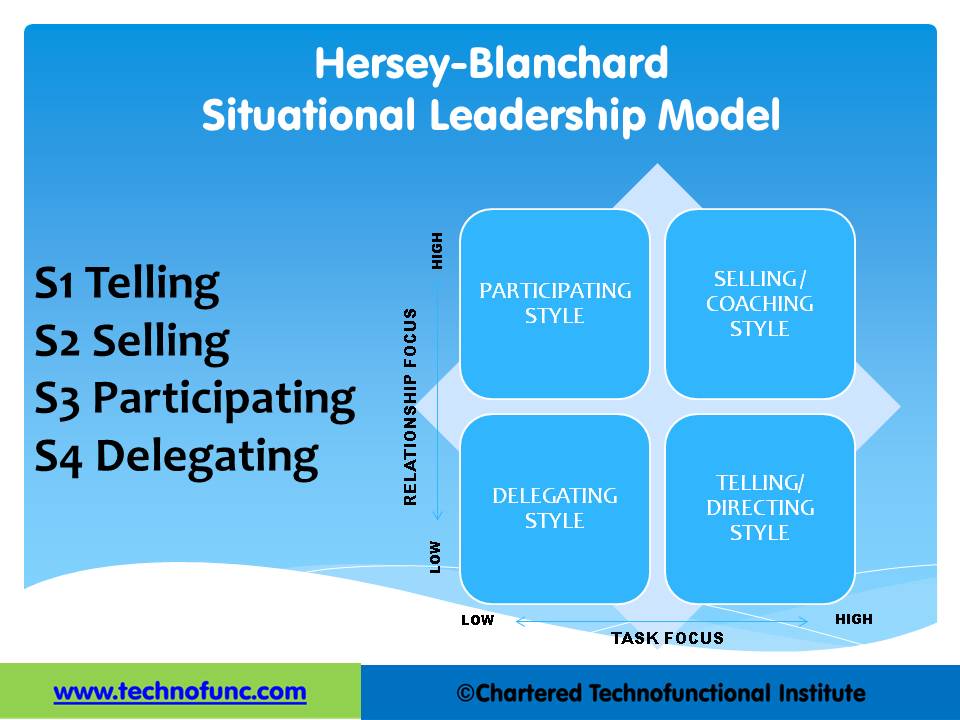- Home
- Business Processes
- Industry Knowledge
- Aerospace Industry
- Automotive Industry
- Banking Domain
- BFSI Industry
- Consumer/ FMCG Industry
- Chemicals Industry
- Engineering & Construction
- Energy Industry
- Education Domain
- Finance Domain
- Hospitality Domain
- Healthcare Industry
- Insurance Domain
- Retail Industry
- Travel and Tourism Domain
- Telecom Industry
- Leadership Skills
- eLearning
- Home
- Leadership
- Change Management
- Situational Leadership - Application
Situational Leadership - Application
Situational Leadership Theories are well known and frequently used for training leaders within organizations. Practical application is how to choose the right leadership approach for the situation. The theory emphasizes leader flexibility and advises leaders to flex their style based on the followers' needs. Leaders must adapt their leadership style to fit the prescribed task, understanding given situation/maturity of followers.
How does this Approach Works?
The situational approach is constructed around the idea that different employees are at different level of development or maturity stages which represents the relative competence and commitment of subordinates for a given task. For leaders to be effective in such situations, it is essential that they determine where subordinates are on the maturity levels and adapt their leadership styles so that their style matches with the style of the development level and the followers can be benefited by the time and energy spent by the leader on it. In a way this approach is mutually beneficial to both follower and the leader as leader can also save his time and energy by understanding the maturity levels of the follower.
It is designed to increase the frequency and quality of conversations about performance and development between managers and the people they work with so that competence is developed, commitment is gained, and talented individuals are retained. Highlighted below are the key learning objectives from this theory:
- Develop an understanding of Interaction Styles and how this model can assist in gaining a greater understanding of yourself and others
- Understand how your preferences can influence you and others
- Understand the importance of adapting own interaction style to increase effectiveness
- Be able to diagnose others’ development levels and choose the appropriate leadership style
- Know why there is no best leadership or coaching style
- Learn to use a common language for coaching and developing others
- Understand the negative impact of over supervision and under supervision on others’ performance and morale
Steps to Apply Situational Leadership Model:
1. Determine the nature of the situation.
2. Understand the nature and complexity of the task at hand
3. Evaluate the skills and the desire of the subordinates to do the task being asked to perform.
4. Identify correctly the specific developmental level at which their subordinates are functioning.
5. Adapt his or her style to the prescribed leadership style represented in the table given in the previous article.
Practical Applications of the Situational Approach:
- This theory is well known and frequently used for training leaders within organizations.
- Perceived by organizations as an effective model for training people to become effective leaders and use the skills in workplace to solve common workplace conflicts.
- Highly practical, easy to understand, sensible theory that can be applied in a variety of settings and situations.
- Provide leaders with a valuable set of guidelines that can facilitate and enhance leadership.
- Emphasizes leader flexibility and recognizes that employees act differently with different tasks and leaders need to flex their style based on the situational or followers need.
- It is an encompassing model with a wide range of applications.

Related Links
You May Also Like
-
There are four major factors in leadership called Leader, Follower, Communication, and Situation. The success of the leader is dependent on how the leader is effectively able to communicate and motivate followers to perform desired tasks using the appropriate leadership style best suited for the given situation. Interdependencies and dynamics of these four factors of leadership must be considered by a leader to be effective.
-
Symbolic Interaction and Social Change
George Herbert Mead, an American philosopher, affiliated with the University of Chicago founded the theory of symbolic interactionism. A major aspect of this is that people interact by symbols both verbal and non-verbal signals and every interaction makes a contribution to the mental make-up of the mind thus every interaction with someone, changes you and you go away a different person signifying that humans and change go together.
-
The Path-Goal theory defines the characteristics of followers and organizational context and the corresponding leadership style best suited to these factors. A leader should adapt to a behavior that is most relevant for a given employee and work environment mix to achieve a goal. The application of theory drives increased employees' motivation, empowerment, and satisfaction resulting in increased productivity.
-
The Hersey and Blanchard Situational Theory model suggests that a leader must adapt his leadership style based on task and relationship behaviors appropriate to the situation. Leadership style is dependent on the maturity level and abilities of followers. Under this model, successful leadership is both task-relevant and relationship-relevant.
-
Leadership traits refer to personal qualities that define effective leaders. Here are the major leadership qualities that can make someone a good leader. Five key traits that are common in leaders can be learned and sharpened with time.
-
Trait theories of leadership explain the leadership traits that have been studied to determine what makes certain people great leaders. The practical application of the theory is looking at how the leader‟s behavior affects their subjects.
-
Attribution Theory of Leadership
The attribution theory of leadership deals with the formation of individual opinions about the reasons for particular events or observations. People will always try to understand why people do what they do. The leader will make a judgment about his employees based on his attribution of the causes of the employees' performance. Individuals will also make inferences about the leader and react to poor performance by the leader.
-
Self-leadership is a normative model of self-influence by the use of several behavioral strategies to gain a comprehensive self-influence perspective about oneself. Self-leadership is developing an understanding of your capabilities and abilities to influence your own communication, emotions, and behaviors to lead and influence others. Self-leadership is about personal growth and developing foresight.
-
Generating Ideas using Brainstorming
The brainstorming technique was developed by Alex F. Osborn in 1957 and brainstorming means where a team of members generates a large amount of alternative fruitful ideas on a specific problem without any criticism and then evaluates each idea in terms of their pros and cons. Brainstorming techniques fall into four broad categories: visioning, exploring, modifying, and experimenting.
-
The style approach emphasizes that one style of leadership behaviour cannot be effective in all situations. Earlier theories treated leadership exclusively as a personality trait and behavior approach has widened the scope by including the behaviors of leaders and what they do in various situations. Explore how you can benefit from the concepts to understand your own behaviors and what are some of the leadership tools based on the style approach to leadership.
Explore Our Free Training Articles or
Sign Up to Start With Our eLearning Courses

About Us
Learning
© 2023 TechnoFunc, All Rights Reserved










